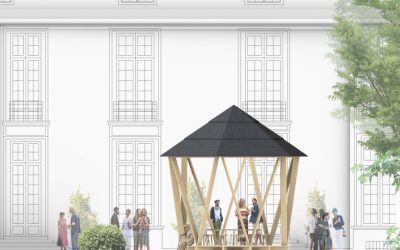Written by Wood Campus
Environmental | Industry | News
If asked to imagine a wind turbine, most people would think of a steel structure—the current form of nearly all wind turbines used for renewable wind energy generation. However, despite what the steel industry claims, it’s hardly a given that wind turbines must be made of steel. Modvion, a Swedish engineered-wood technology company that develops modular designs, believes it’s not only feasible but that towers should be built from wood.
Futurist Jim Carroll observes that this rethinking of wind turbines’ materials aligns with two key trends: one, the broader acceleration of new material science; and two, the emergence of a “real focus on how to utilise wood in construction in ways that weren’t previously possible”.
Compared to traditional wind towers, Modvion’s modular towers are easier to transport, comprised of lighter component parts and cheaper to scale. Modvion CEO Otto Lundman explains: “Conventional towers are shipped in cylinders, which becomes a logistical issue at greater heights. Modvion towers use a modular design, allowing good logistics at much greater heights.” Modvion towers’ efficiency gains are best realised at heights over 120 metres.
Although steel is stronger than wood per volume, Modvion’s Laminated Veneer Lumber (LVL) and Gluelam Timber (GLT) products are both 55% stronger than steel per mass unit and more cost-effective than steel at the same load-bearing capacity. “Modvion towers with strength properties equal to steel towers weigh two-thirds as much and cost less to produce,” says Lundman.
Wood can also create additional advantages beyond cost and strength. Unlike steel, which is often shipped over great distances, timber is often locally available, benefiting local jobs and economies.
Robert Jockwer, an assistant professor of Timber Structures at Chalmers University, adds that wood is also superior to steel for maritime climates. While saltwater is harsh on steel, “saltwater doesn’t have such a negative impact on timber. It shouldn’t get wet, but the maritime climate, with some salt in the air, is not a problem for timber. For these special climates, timber can be better than steel.”
Continue Reading: UPM TIMBER
More News
Softwood supply finally catching construction demand
More than seven million m3 of timber and panel products were imported by the UK between January and July 2021, according to the latest Timber Trade Federation (TTF) Market Statement. This is nearly two million m3 above the same period in 2020, and half a million m3...
Hexagonal pavilion in the institut suedois
Paris Design Week – September 2021 – The Hexagonal Pavilion The Hexagonal Pavilion is a joint initiative between Swedish Wood and Swedish architects. It was conceived by Swedish architectural practice, In Praise of Shadows, in partnership with construction company,...
Fundamentals of timber trees and the nature of wood
Learn with TRADA Live: Fundamentals of timber provides a comprehensive overview of the many aspects of timber and is intended as an introductory resource for newcomers to the material and those looking to construct a strong foundational layer of knowledge upon which...
Swedish wood announced as BIID platinum partner
The British Institute of Interior Design (BIID) provide a Platinum Partner programme for Industry Partners wishing to work closely with the Institute and Swedish Wood have become their latest member.Swedish Wood are celebrating their new partnership by giving BIID...





